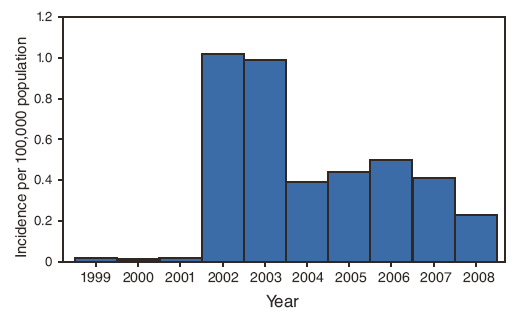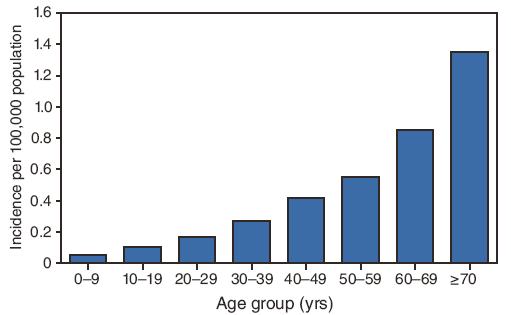Introduction
West Nile Virus, abbreviated as WNV, is a virus borne by a vector. Being zoonotic by nature, the virus may be transmitted between species. This phenomenon is also referred to as anthroponosis or reverse zoonosis. This virus is naturally maintained in a transmission cycle between the mosquito and the bird. The species of mosquitoes that are involved include the Culex pipiens, Culex quinquefasciantus, and Culex tarsalis. The natural reservoir hosts for the virus are the birds. When infected, the birds develop a high level of the infection such that mosquitoes that come to feed become infected. Some mosquitoes become ill after the infection and die. However, some survive from the infection. With time, they develop permanent immunity and are not affected. Man is considered the dead-end host. For this reason, they are infected but do not develop high levels of the infection that would cause subsequent infection of the feeding mosquitoes (Lindsey, Staples, Lehman, & Fischer, 2010).
Due to the nature of the virus and its infections, thorough study on WNV is required. Studies are required to investigate the various ways to contain the virus and reduce its infection rates. Several studies have been done before and the results are alarming. Another reason why studies on the virus are necessary is due to the fact that approximately 80% of all infections are asymptomatic. These kinds of infections are also referred to as subclinical infections. This means that after infection by the virus, an individual may show no symptoms whatsoever. This characteristics make WNV deadly since an infected person may not show any noticeable symptoms and therefore unknowingly spread the infection to others. At this point also, the infection might have caused great harm since the individual would not be under medication.
Another reason for the need for further studies is due to its increasing trend and the fact that it affects a large percentage of the population. The virus was ones located in a single area in Africa but has spread systematically to other regions and is now present globally. Thousands of cases of both neuroinvasive and non-neuroinvasive WNV disease have been reported in several states in the world. Several studies have been done to assess the public health impact of the WNV disease. Risk factors have also been determined through sound research. Studies have also identified the populations that are at high risk for infections.
Descriptive Epidemiology
In 1937, the virus was first detected in Uganda. This is the West Nile sub region in East Africa. Before the 90s, WNV disease was not common and it was not considered a high risk factor. However, this perception changed after an outbreak that occurred in Algeria in the mid-90s. During the same period, another case was reported in Romania. A large percentage of those cases were neuroinvasive. This means that the virus had the ability to infect the nerve cells and affect the nervous system.
WNV is no longer strange since it has now spread globally. In the west, the virus was first identified in 1999. Over a short period, it had spread widely over the United States (Lindsey, Kuhn, Campbell, & Hayes, 2008). Several cases were also reported in Canada, Latin America, Europe, and the Caribbean Islands. Recent cases of infection were reported in Italy in 2012. The virus is said to be endemic in various areas of the world and has caused many deaths.
On a particular study to assess the prevalence of the disease, data was collected over the period between 1999 and 2008. The study showed that during the period between 2000 and 2001, less than 100 cases were reported per year. This was despite the fact that the virus had spread substantially over the geographic area. In six years’ time, the number had increased and cases had been reported in all states apart from Maine (Lindsey, Staples, Lehman, & Fischer, 2010). However, the disease is believed to generally spread to any geographical area. This also explains how the disease ended up in the western hemisphere after it was first identified in the eastern Africa. The cases of occurrence are fairly distributed geographically. Therefore, there is no particular region that can be associated with the disease. A trend was observed in that an annual epidemic peak existed. Despite the fact that cases of the disease were reported every other week of the year, the greatest proportion (93%) reported the onset of the disease during the period between July and September. As for the United States, the peak always recurred in August. This provided evidence that the disease has a definite distribution relating to time. This makes it predictable in case intervention is to be considered.

In terms of the persons most affected by the WNV disease, studies have shown that the disease is also prevalent among specific age groups. The neuroinvasive disease and non-neuroinvasive disease affect individuals differently depending on their age groups. For the case of non-neuroinvasive disease, the persons from ages 40 to 59 were the most vulnerable persons. In terms of fatalities, the persons who easily succumbed to the disease were those aged above 70 years. For neuroinvasive disease, on the other hand, the most affected individuals were those from ages 60 and above. The individuals from this group were also very vulnerable and were most likely to succumb to the disease. Another trend was in the fact that case-fatality ratio increased with increase in age. This meant that the older ones were more likely to succumb to the disease. The cases of neuroinvasive disease were also higher among the males. This was particularly among the individuals of ages 60 and above.

Rates
One of the results from the study indicated that about 29,000 cases of WNV disease were reported in 47 states in the U.S. Of all the cases, 41% were neuroinvasive. Of all the cases of non-neuroinvasive disease (about 17,000), 52% of the victims were male and 48% female. The age group that reported the highest number of cases was that of persons between 40 and 59 years old. This group reported 45% of all the cases. Judging from the distribution of the disease among races, the whites made up 95% of the bulk. However, race data was not available for the entire population. From the ethnicity data available, it was determined that the non-Hispanic population was most affected. This made about 90% of the cases of infection. The onset of most of the cases of non-neuroinvasive disease was reported between July and September. Among the cases reported in the next four years starting from the year 2004, 21% of the victims ended up in hospital. A few of these cases were fatal and resulted in death. Among those who succumbed to the disease, 82% were aged 70 years and above (Lindsey, Staples, Lehman, & Fischer, 2010).

As for the neuroinvasive disease, females accounted for 42% of all cases. Males made up the greater proportion of 58%. Among all the cases, the persons of ages 60 and above reported almost half of all the cases. The cases of infection of the disease were prevalent among the whites, who made up 88% of the whole population. Eighty two percent of the victims were non-Hispanic. Just as in the case of the non-neuroinvasive disease, the onset peak was during the period between July and September. From the 86% who ended up in hospital, hospitalization rates were higher among individuals of ages fifty and above. This age group made up 92% of the population. In comparison to the non-neuroinvasive disease, a greater proportion (9%) of the neuroinvasive disease was fatal. The number of fatalities increased with age. Those between 50 and 60 years of age reported more deaths than those between 40 and 50. Subsequently, those of ages above 60 reported the highest number of deaths (Lindsey, Staples, Lehman, & Fischer, 2010).
Causes and Risk Factors
The disease is caused when the virus transmitted through the female mosquitoes. They are the prime vectors of the virus. Only the female mosquitoes feed on blood, therefore, they are the agents that transmit the virus. Mosquitoes also have preferences when it comes to blood meals. Those that transmit the virus particularly prefer the Passeriformes. This order of birds is the largest. After infection, the bird develops high levels of the virus such that a feeding mosquito would get the virus and subsequently infect other birds. Due to the fatal nature of the infection within the first few days, the infected bird species may die off. Carrier mosquitoes that may want to feed later may not find the preferred bird species and opt for an alternative (readily available meal). These alternatives may be the horses and humans. After humans are infected, the disease may be spread through transfusions, transplants or breast-feeding (Brown, Factor, & Tkachenko, 2007).
There are several risk factors associated with the disease. One of the risk factors is a suppressed immune system. Another factor is the individual’s history of organ transplantation (Pealer, Marfin, & Petersen, 2003). Old age has also been determined to be a risk factor. Particularly, persons of ages 50 and above are at high risk of infection. Sex is also another factor. The males have been determined to be at a higher risk of infection. Studies have also shown that persons with diabetes and hypertension are at a higher risk of infection than healthy individuals (Patnaik, Harmon, & Vogt, 2006). Some genetic factors were also associated to susceptibility to the disease.
Conclusion
The WNV disease is spread by the female mosquito. For this reason, several precautions can be taken to reduce the risks of infection. One of the ways of doing this is by using insect repellent on exposed skin. This would help to repel mosquitoes attempting to land on human skin. The use of mosquito nets may also play a huge role in preventing the spread of WNV. Individuals may also dress appropriately in order to prevent infection through biting. One could wear long trousers and long-sleeved tops to cover skin as much as possible. It has been determined that these notorious mosquitoes are mainly active at dawn and dusk. Therefore, it is important to put in place the preventative measures especially during these times of the day.
References
Brown, J., Factor, D., & Tkachenko, N. (2007). West Nile viremic blood donors and risk factor for subsequent West Nile fever. Vector Borne Zoonotic Dis, 7(1), 479-488.
Lindsey, N., Kuhn, S., Campbell, G., & Hayes, E. (2008). West Nile Virus neuroinvasive disease incidence in the United States. Vector Borne Zoonotic Dis, 8(1), 35-39.
Lindsey, N., Staples, E., Lehman, J., & Fischer, M. (2010). Surveillance for Human West Nile virus disease – United States. Surveillance Summaries, 59(2), 1-17.
Patnaik, J. Harmon, H., & Vogt, R. (2006). Follow-up of 2003 human West Nile Virus infections, Denver, Colorado. Emerg Infect Dis, 12(1), 1129-1131.
Pealer, L., Marfin, A., & Petersen, L. (2003). Transmission of West Nile Virus through blood transfusion in the United States in 2002. N Engl J Med, 349(1), 1236-1245.